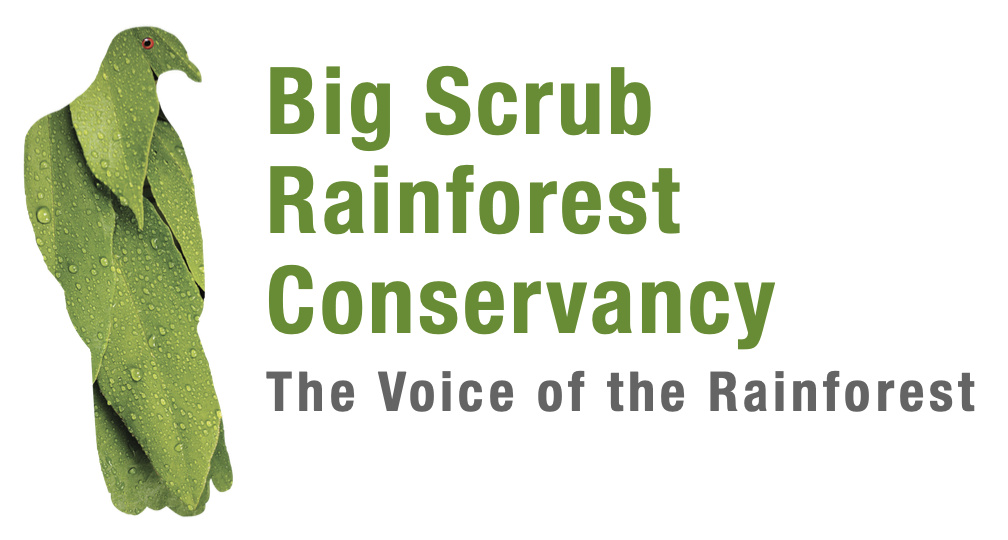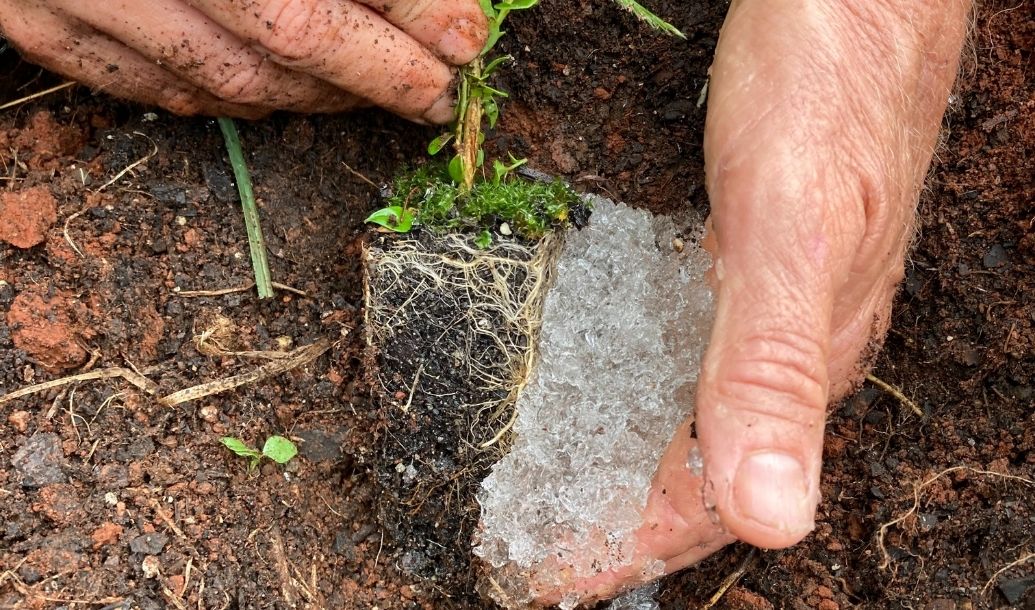By Mark Dunphy and Joe Harvey Jones
People are always asking whether they should use water crystals with opinions on their effectiveness varying greatly. Some regenerators swear by them, including them in plantings of tens of thousands of trees, while others think their effectiveness is limited.
With tree planting numbers ramping up by the tens of thousands every year and planting outside of the traditional wet season increasing, survival rates will become even more of a challenge. On top of this, climate change is increasing extreme weather conditions, which means extended dry periods will become more common.
For these reasons, plantings are going to need all the help they can get to establish and mature quickly. Fortunately a member of Big Scrub Landcare, Joe Harvey Jones, has done a PhD on water crystals and can help us sort fact from fiction.
What are hydrogels?
Water crystals or hydrophilic gels, or “hydrogels”, which are also commonly known as superabsorbents, are crosslinked polymers that can absorb 400 to 1500 times their dry weight in water. Most of the early hydrophilic polymers were destined for non-agricultural uses, such as disposable nappies, but have also found use in diverse applications like oil recovery, food processing, water purification and wound dressings.
The chemical composition of hydrogels are mostly petrochemical based polymers. The exact chemical composition of hydrogel products are trade secrets and many are simply described as “polymers” or “polyacrylamide”.
For tree plantings, they’re used to help provide water to the plant when there is a shortage of water in the soil.

Do hydrogels work?
The research says they definitely work. They are an effective way of increasing survival rates in those critical first few months, according to the majority of research conducted, particularly in sandy and heavy clay soils or arid and semi-arid environments. Less research has been conducted in tropical areas and loamy soils, however findings suggest the results are still positive.
How long do hydrogels work for?
This is highly dependent on soil type and climate, however the hydrogel will provide approximately one month of water to the plant when there is little to no rainfall. They will fully rehydrate if it rains or the plant is watered. This can happen a number of times, as the hydrogel will last a few years before it degrades and loses its structural stability.
What else do hydrogels do for the plant?
Hydrogels don’t just increase the survival rates of plantings, they also provide a number of benefits to help trees thrive and mature. Water crystals can help improve:
- Growth rates: As water is available in a consistent supply, plants will increase growth rates in the critical early stages of establishment.
- Nutrient availability: Hydrogels increase the nutrient use efficiency of plants through reduction of the leaching of nutrients, particularly the micro-nutrients from the soil. Furthermore, Hydrogels with slow-release synthetic fertilizers will release nutrients very slowly over a very long period of time, and this allows some rapidly available nutrients such as ammonium phosphate, ammonium nitrate and potassium chloride to be available to plants in a consistent way.
- Soil health: Hydrogels help the formation of soil aggregates (peds) and thereby decrease the bulk densities of soil, increase water retention, soil moisture, aeration and texture. Hydrogels also improve the physical conditions of soils such as soil infiltration rate, permeability, porosity, the microbial/ biological activities and air accessibility in the root zone of plants.
- Root growth: Roots love hydrogels and tend to grow towards and into them. The hydrogels provide water and provide sustained nutrients in the early growth of the tree.
Hydrogels can also be bought with additives such as control released fertiliser, mycorrhizal spores and biostimulant additives that further promote root development.
Disadvantages of hydrogels
The main disadvantage is too much water. If hydrogels are used in wet conditions like the current La Niña we are experiencing at the moment there can be too much water around the roots that does not drain away and may slow the growth or drown the plant. This may be more of a problem on heavy poor draining clays than on sand or red ferrosol soils.
How to use hydrogels
1. Fully hydrate before use
The hydrogel must be fully hydrated before use, which can take up to 30 minutes. To ensure this is the case keep adding water and mixing till water is sitting unabsorbed on the surface. Placing the unhydrated powder in the hole and planting the tree on top will result the hydrogel taking in water, expanding and pushing the planted tree out of the ground.

2. What can I mix with hydrogels?
Some hydrogels come mixed with mycorrhizal spores and slow release fertilizers though they are not common. Most people buy pure hydrogel and customise it by adding their own fertilisers to the hydrogel. All fertilisers effect the structure of the polymer and reduce the water holding capacity of the hydrogel, however slow-release fertilizers such as Nutricote are significantly better than liquid fertilizers such as Aquasol or Charlie Carp.
3. How much do I use?
When planting a 50mm or 70mm tube people have used anything between a small handful and half a bucket of hydrogel. I have not found any data on the optimal amount, though 300mm to 600mm is commonly used.
4. Where should I place the crystals?
This is critical to the hydrogels effectiveness. Do not mix it into the soil or put it in the bottom of the hole with soil on top. It is important to place the hydrogel in direct contact with the root zone of the planted tree. On a dry site or season completely surrounding the root ball is desirable, while in a wet year it is best to keep it all to one side to allow some of the root ball to drain.

In conclusion, water crystals are an effective way to increase survival and growth rates. They can replace the need to water at planting, though watering in is preferred in addition to the hydrogel. In a time where planting rates are increasing and climate is becoming more unpredictable, water crystals are a great tool for maximising success.
References:
Mekonnen G, Efrem G. Hydrogel: A Promising Technology for Optimization of Nutrients and Water in Agricultural and Forest Ecosystems. Int J Environ Sci Nat Res. 2020;
Landis TC, Haase DL. 2012. Applications of hydrogels in the nursery and during outplanting.
In: Haase DL, Pinto JR, Riley LE, technical coordinators. National Proceedings:
Forest and Conservation Nursery Associations—2011. Fort Collins (CO): USDA Forest
Service, Rocky Mountain Research Station. Proceedings RMRS-P-68. 53-58. Available
at: http://www.fs.fed.us/rm/pubs/rmrs_p068.html
Jacob W Crous (2017) Use of hydrogels in the planting of industrial
wood plantations, Southern Forests: a Journal of Forest Science, 79:3, 197-213, DOI:
10.2989/20702620.2016.1221698
To link to this article: https://doi.org/10.2989/20702620.2016.1221698


